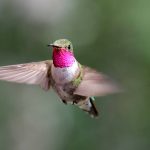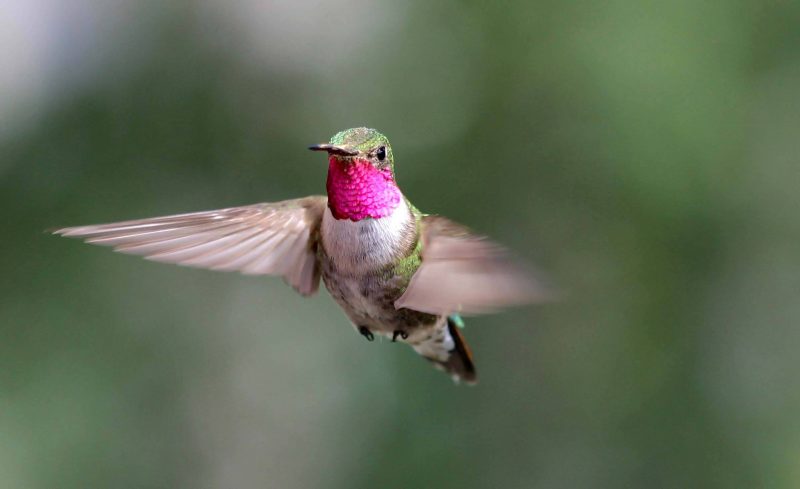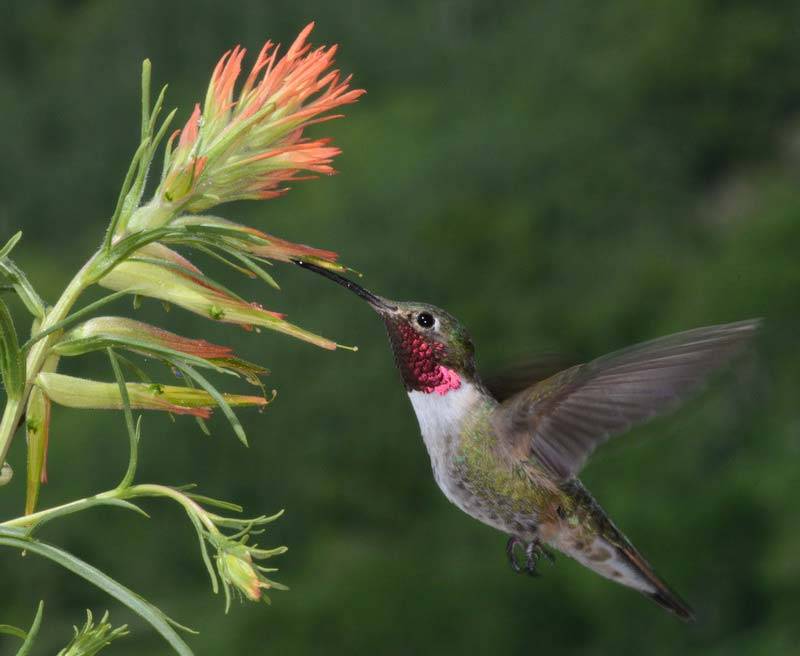

Male broad-tailed hummingbird. Researchers trained birds like these to perform experiments that revealed that the birds see colors invisible to human eyes. Image via Noah Whiteman (UC-Berkeley)/ Princeton University.
You know the old idea that dogs see only in shades of gray? Studies have shown that’s not true. Dogs do see some colors, though their color vision doesn’t reveal a world as richly or intensely colored as the world we see. Now a new study by scientists, published this month in the peer-reviewed journal Proceedings of the National Academy of Sciences, shows that our human color vision can’t compete with that of wild hummingbirds. These fleet little birds perceive a world far more richly hued than ours, full of visual cues humans never notice, via colors we can’t imagine. In fact, said evolutionary biologist Mary (Cassie) Stoddard at Princeton:
Humans are color-blind compared to birds and many other animals.

To other hummingbirds, this male’s magenta throat feathers likely appear as an ultraviolet+purple combination color. Image via David Inouye (U. of Maryland-College Park)/ Princeton University.
When it comes to color vision, you can thank the cone cells in the retina of your eye. Humans have three types of color cones, making us sensitive to red, green and blue light. Birds have a fourth color cone that can detect ultraviolet light. The tiny hummingbirds also see combination colors like ultraviolet+green and ultraviolet+red, according to the new research. The hummingbirds rely on their heightened color sense to find food, dazzle mates, escape predators and navigate diverse terrain, these scientists said.
To investigate how birds perceive color, Stoddard and her research team explored bird color vision in a natural setting. They worked at the Rocky Mountain Biological Laboratory in Gothic, Colorado, training wild broad-tailed hummingbirds (Selasphorus platycercus) to participate in color vision experiments. In the scientists’ statement, Stoddard explained:
Most detailed perceptual experiments on birds are performed in the lab, but we risk missing the bigger picture of how birds really use color vision in their daily lives.
Hummingbirds are perfect for studying color vision in the wild. These sugar fiends have evolved to respond to flower colors that advertise a nectar reward, so they can learn color associations rapidly and with little training.
The team said it was particularly interested in nonspectral color combinations, which involve hues from widely separated parts of the color spectrum. That’s as opposed, they said:
… to blends of neighboring colors like teal (blue-green) or yellow (green-red). For humans, purple is the clearest example of a nonspectral color. Technically, purple is not in the rainbow: it arises when our blue (short-wave) and red (long-wave) cones are stimulated, but not green (medium-wave) cones.
While humans have just one nonspectral color – purple – birds can theoretically see up to five: purple, ultraviolet+red, ultraviolet+green, ultraviolet+yellow and ultraviolet+purple.

View larger. | Infographic by the Stoddard Lab/ Princeton University.
Stoddard and her colleagues designed a series of experiments to test whether hummingbirds can see these nonspectral colors. They performed outdoor experiments each summer for three years, starting with a pair of custom “bird vision” LED tubes programmed to display a broad range of colors, including nonspectral colors like ultraviolet+green. Next, they performed experiments in an alpine meadow frequently visited by local broad-tailed hummingbirds. Their statement said:
Each morning, the researchers rose before dawn and set up two feeders: one containing sugar water and the other plain water. Beside each feeder, they placed an LED tube. The tube beside the sugar water emitted one color, while the one next to the plain water emitted a different color. The researchers periodically swapped the positions of the rewarding and unrewarding tubes, so the birds could not simply use location to pinpoint a sweet treat. They also performed control experiments to ensure that the tiny birds were not using smell or another inadvertent cue to find the reward. Over the course of several hours, wild hummingbirds learned to visit the rewarding color. Using this setup, the researchers recorded over 6,000 feeder visits in a series of 19 experiments.
The experiments revealed that hummingbirds can see a variety of nonspectral colors, including purple, ultraviolet+green, ultraviolet+red and ultraviolet+yellow. For example, hummingbirds readily distinguished ultraviolet+green from pure ultraviolet or pure green, and they discriminated between two different mixtures of ultraviolet+red light – one redder, one less so.
Harold Eyster, a UBC Ph.D. student and a co-author of the study, commented:
It was amazing to watch. The ultraviolet+green light and green light looked identical to us, but the hummingbirds kept correctly choosing the ultraviolet+green light associated with sugar water. Our experiments enabled us to get a sneak peek into what the world looks like to a hummingbird.
Even though hummingbirds can perceive nonspectral colors, appreciating how these colors appear to birds can be difficult, the scientists said. Ben Hogan, a postdoctoral research associate at Princeton and a co-author of the study, commented:
It’s impossible to really know how the birds perceive these colors. Is ultraviolet+red a mix of those colors, or an entirely new color? We can only speculate.
Stoddard added:
To imagine an extra dimension of color vision – that is the thrill and challenge of studying how avian perception works. Fortunately, the hummingbirds reveal that they can see things we cannot.
David Inouye, who is affiliated with the University of Maryland and the center where the study took place, added:
The colors that we see in the fields of wildflowers at our study site, the wildflower capital of Colorado, are stunning to us, but just imagine what those flowers look like to birds with that extra sensory dimension.
The scientists said the wide variety of nonspectral colors available to birds is the result of their ancient four color-cone visual system. Stoddard explained:
Tetrachromacy – having four color cone types – evolved in early vertebrates. This color vision system is the norm for birds, many fish and reptiles, and it almost certainly existed in dinosaurs. We think the ability to perceive many nonspectral colors is not just a feat of hummingbirds but a widespread feature of animal color vision.

The research team studied hummingbirds at the Rocky Mountain Biological Laboratory in Gothic, Colorado. The high-altitude site, at an elevation of nearly 10,000 feet (3,000 meters), is home to many broad-tailed hummingbirds. The research team included (from left): Prof. Mary “Cassie” Stoddard; Cole Morokhovich of the Class of 2020; Harold Eyster, a Ph.D. student at the University of British Columbia; and postdoctoral research associate Ben Hogan. Stoddard, Eyster and Hogan are authors on the paper appearing this week in PNAS. Photo via Princeton University.
Bottom line: A new series of experiments shows that wild hummingbirds perceive a world far more richly colored than ours, full of visual cues humans can never perceive via colors we can’t imagine.
Source: Wild hummingbirds discriminate non-spectral colors
from EarthSky https://ift.tt/37QDvGq


Male broad-tailed hummingbird. Researchers trained birds like these to perform experiments that revealed that the birds see colors invisible to human eyes. Image via Noah Whiteman (UC-Berkeley)/ Princeton University.
You know the old idea that dogs see only in shades of gray? Studies have shown that’s not true. Dogs do see some colors, though their color vision doesn’t reveal a world as richly or intensely colored as the world we see. Now a new study by scientists, published this month in the peer-reviewed journal Proceedings of the National Academy of Sciences, shows that our human color vision can’t compete with that of wild hummingbirds. These fleet little birds perceive a world far more richly hued than ours, full of visual cues humans never notice, via colors we can’t imagine. In fact, said evolutionary biologist Mary (Cassie) Stoddard at Princeton:
Humans are color-blind compared to birds and many other animals.

To other hummingbirds, this male’s magenta throat feathers likely appear as an ultraviolet+purple combination color. Image via David Inouye (U. of Maryland-College Park)/ Princeton University.
When it comes to color vision, you can thank the cone cells in the retina of your eye. Humans have three types of color cones, making us sensitive to red, green and blue light. Birds have a fourth color cone that can detect ultraviolet light. The tiny hummingbirds also see combination colors like ultraviolet+green and ultraviolet+red, according to the new research. The hummingbirds rely on their heightened color sense to find food, dazzle mates, escape predators and navigate diverse terrain, these scientists said.
To investigate how birds perceive color, Stoddard and her research team explored bird color vision in a natural setting. They worked at the Rocky Mountain Biological Laboratory in Gothic, Colorado, training wild broad-tailed hummingbirds (Selasphorus platycercus) to participate in color vision experiments. In the scientists’ statement, Stoddard explained:
Most detailed perceptual experiments on birds are performed in the lab, but we risk missing the bigger picture of how birds really use color vision in their daily lives.
Hummingbirds are perfect for studying color vision in the wild. These sugar fiends have evolved to respond to flower colors that advertise a nectar reward, so they can learn color associations rapidly and with little training.
The team said it was particularly interested in nonspectral color combinations, which involve hues from widely separated parts of the color spectrum. That’s as opposed, they said:
… to blends of neighboring colors like teal (blue-green) or yellow (green-red). For humans, purple is the clearest example of a nonspectral color. Technically, purple is not in the rainbow: it arises when our blue (short-wave) and red (long-wave) cones are stimulated, but not green (medium-wave) cones.
While humans have just one nonspectral color – purple – birds can theoretically see up to five: purple, ultraviolet+red, ultraviolet+green, ultraviolet+yellow and ultraviolet+purple.

View larger. | Infographic by the Stoddard Lab/ Princeton University.
Stoddard and her colleagues designed a series of experiments to test whether hummingbirds can see these nonspectral colors. They performed outdoor experiments each summer for three years, starting with a pair of custom “bird vision” LED tubes programmed to display a broad range of colors, including nonspectral colors like ultraviolet+green. Next, they performed experiments in an alpine meadow frequently visited by local broad-tailed hummingbirds. Their statement said:
Each morning, the researchers rose before dawn and set up two feeders: one containing sugar water and the other plain water. Beside each feeder, they placed an LED tube. The tube beside the sugar water emitted one color, while the one next to the plain water emitted a different color. The researchers periodically swapped the positions of the rewarding and unrewarding tubes, so the birds could not simply use location to pinpoint a sweet treat. They also performed control experiments to ensure that the tiny birds were not using smell or another inadvertent cue to find the reward. Over the course of several hours, wild hummingbirds learned to visit the rewarding color. Using this setup, the researchers recorded over 6,000 feeder visits in a series of 19 experiments.
The experiments revealed that hummingbirds can see a variety of nonspectral colors, including purple, ultraviolet+green, ultraviolet+red and ultraviolet+yellow. For example, hummingbirds readily distinguished ultraviolet+green from pure ultraviolet or pure green, and they discriminated between two different mixtures of ultraviolet+red light – one redder, one less so.
Harold Eyster, a UBC Ph.D. student and a co-author of the study, commented:
It was amazing to watch. The ultraviolet+green light and green light looked identical to us, but the hummingbirds kept correctly choosing the ultraviolet+green light associated with sugar water. Our experiments enabled us to get a sneak peek into what the world looks like to a hummingbird.
Even though hummingbirds can perceive nonspectral colors, appreciating how these colors appear to birds can be difficult, the scientists said. Ben Hogan, a postdoctoral research associate at Princeton and a co-author of the study, commented:
It’s impossible to really know how the birds perceive these colors. Is ultraviolet+red a mix of those colors, or an entirely new color? We can only speculate.
Stoddard added:
To imagine an extra dimension of color vision – that is the thrill and challenge of studying how avian perception works. Fortunately, the hummingbirds reveal that they can see things we cannot.
David Inouye, who is affiliated with the University of Maryland and the center where the study took place, added:
The colors that we see in the fields of wildflowers at our study site, the wildflower capital of Colorado, are stunning to us, but just imagine what those flowers look like to birds with that extra sensory dimension.
The scientists said the wide variety of nonspectral colors available to birds is the result of their ancient four color-cone visual system. Stoddard explained:
Tetrachromacy – having four color cone types – evolved in early vertebrates. This color vision system is the norm for birds, many fish and reptiles, and it almost certainly existed in dinosaurs. We think the ability to perceive many nonspectral colors is not just a feat of hummingbirds but a widespread feature of animal color vision.

The research team studied hummingbirds at the Rocky Mountain Biological Laboratory in Gothic, Colorado. The high-altitude site, at an elevation of nearly 10,000 feet (3,000 meters), is home to many broad-tailed hummingbirds. The research team included (from left): Prof. Mary “Cassie” Stoddard; Cole Morokhovich of the Class of 2020; Harold Eyster, a Ph.D. student at the University of British Columbia; and postdoctoral research associate Ben Hogan. Stoddard, Eyster and Hogan are authors on the paper appearing this week in PNAS. Photo via Princeton University.
Bottom line: A new series of experiments shows that wild hummingbirds perceive a world far more richly colored than ours, full of visual cues humans can never perceive via colors we can’t imagine.
Source: Wild hummingbirds discriminate non-spectral colors
from EarthSky https://ift.tt/37QDvGq

Aucun commentaire:
Enregistrer un commentaire